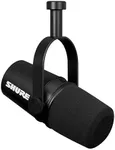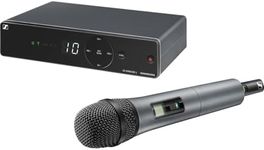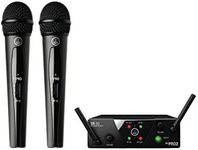Buying Guide for the Best Microphones For Live Vocals
Choosing the right microphone for live vocals is essential for delivering clear, powerful, and natural-sounding performances. The right microphone will help your voice cut through the mix, reduce unwanted noise, and withstand the rigors of live use. When shopping for a live vocal microphone, it's important to understand the key features that affect sound quality, durability, and usability. By focusing on these aspects, you can find a microphone that matches your singing style, performance environment, and personal preferences.Microphone Type (Dynamic vs. Condenser)Microphones for live vocals are mainly either dynamic or condenser types. Dynamic microphones are more common for live performances because they are durable, handle loud sounds well, and are less sensitive to background noise. Condenser microphones are more sensitive and can capture more detail, but they are also more fragile and can pick up unwanted sounds in noisy environments. If you perform in loud venues or move around a lot, a dynamic microphone is usually the better choice. If you sing in quieter, controlled settings and want more vocal detail, a condenser might be suitable.
Polar PatternThe polar pattern describes how a microphone picks up sound from different directions. The most common pattern for live vocals is cardioid, which picks up sound mainly from the front and rejects noise from the sides and rear, helping to reduce feedback and background noise. Supercardioid and hypercardioid patterns offer even more focused pickup, which can be helpful in very loud environments but require more precise microphone positioning. If you perform on crowded or noisy stages, a tighter polar pattern can help isolate your voice, but for general use, cardioid is a safe and versatile choice.
Frequency ResponseFrequency response refers to the range of sound frequencies a microphone can capture. For live vocals, you want a microphone that emphasizes the frequencies of the human voice, typically between 80 Hz and 15 kHz. Some microphones are tailored to boost certain frequencies, like the presence range (around 4-6 kHz), to help vocals stand out. If you have a deep voice, look for a microphone with good low-end response; if your voice is higher, a model with a clear high-frequency response can add brightness. Consider your vocal style and choose a microphone with a frequency response that complements it.
Handling Noise and DurabilityHandling noise is the unwanted sound picked up when you move or touch the microphone. Live vocal microphones are designed to minimize this, but some do a better job than others. Durability is also crucial, as live microphones are often dropped or bumped. If you perform energetically or share microphones with others, look for models known for rugged construction and low handling noise. This ensures your microphone will last and your performance will sound clean.
Connectivity (Wired vs. Wireless)Microphones can be wired or wireless. Wired microphones are simple, reliable, and don’t require batteries, making them a popular choice for many performers. Wireless microphones offer freedom of movement on stage but require batteries and can be affected by interference. If you move around a lot or perform in large venues, wireless might be worth considering. If you mostly stay in one place or want a straightforward setup, a wired microphone is often best.

















